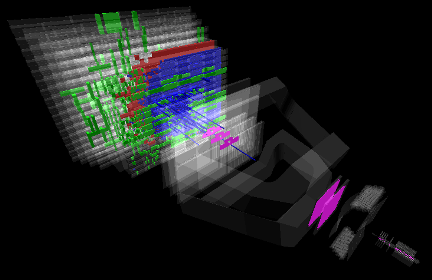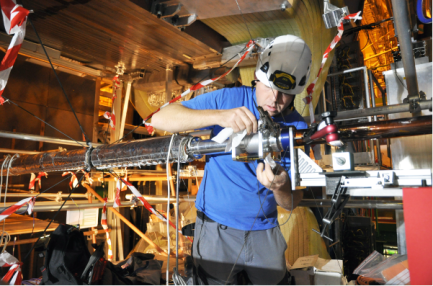The LHCb collaboration is ready to take 13 TeV proton-proton collision data.
This weekend the LHC proton beam has traversed the LHCb detector for the first time in over two years. At the end of November 2014 the proton beam already arrived at a stopper placed in the accelerator known as the “TED”, located at the end of the SPS-LHC transfer line about 300m from the LHCb detector, see 23 November 2014 news.
This weekend the TED exercise was repeated and the LHCb Collaboration recorded again muons produced by protons absorbed in the TED. The TED was then opened and the proton beam entered the LHC ring and was first absorbed in another stopper called the “TDI” located inside the LHC ring about 50m from the LHCb detector. A very large number of particles produced during this absorption process traversed the LHCb detector. Later on the TDI was opened, the proton beam traversed the LHCb detector inside its beam pipe, then travelled through one quarter of the LHC circumference and finally arrived to the LHC beam dump area. The left image shows places, called “hits” by physicists, at which muons from the proton beam interaction at the TED traversed different LHCb sub-detectors. Click the picture and play with the 3D view of these events.
Both proton beams are expected to make the full turn of the LHC collider by the end of March and the first proton-proton collisions at the nominal Run 2 energy of 13 TeV are expected by the end of May.
The LHCb collaboration is ready to take high energy proton-proton collision data. The two year Long Shutdown (LS1) period offered an opportunity for prolonged access, and hence an extensive programme of consolidation and maintenance work. In summer 2014 a detailed field measurement of the LHCb dipole magnet was performed followed by the re-installation of the beam pipe, see the left image, through which proton beams will circulate in both directions. One section of the beryllium beam pipe was replaced. The new beam pipe support structure is now much lighter and therefore unwanted interactions with it of particles measured inside the LHCb detector are strongly reduced.
Read more in the CERN news1 and news2, in the 24 January 2014 “underground” news, in the CERN PH department newsletter, in the CERN Bulletin article and in the CERN Courier article.


